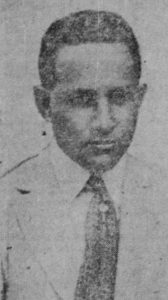 George Kawaelani Dwight was born in Honolulu, Hawaiʻi, on November 15, 1890. He was the son of Ellen H. Dwight and a member of a large and well-known family in the city. As of the 1910 census, George lived at 1543 Makiki Street with his mother and five siblings: Bernice, Ellen K., Joseph L., James A., and Charles D. Dwight.
George Kawaelani Dwight was born in Honolulu, Hawaiʻi, on November 15, 1890. He was the son of Ellen H. Dwight and a member of a large and well-known family in the city. As of the 1910 census, George lived at 1543 Makiki Street with his mother and five siblings: Bernice, Ellen K., Joseph L., James A., and Charles D. Dwight.
Before joining the U.S. Army during World War I, George worked as the chief bookkeeper at Lewers & Cooke, a prominent local hardware and lumber company located on King Street. He had previously worked at the Honolulu Star-Bulletin and was a graduate of McKinley High School. At the time of his draft registration, he was single and living with his family on Makiki Street.
George Dwight was among the first from Hawaiʻi to enlist in the newly formed Gas and Flame Corps, a specialized unit under the 30th Engineers. In December 1917, he left Honolulu for training, first at Angel Island and later at Fort Myer, Virginia. He was eventually stationed in Annapolis, Maryland.
On January 27, 1918, George Dwight died in a hospital at Annapolis. Though specific medical details were not confirmed, it was widely believed he succumbed to pneumonia, likely caused by exposure to the severe East Coast winter weather. He was 27 years old.
His death came as a shock to family and friends. Letters received shortly before had described him as healthy and in good spirits. Military officials, including Captain L. Lowenberg of the 30th Engineers, notified his mother by telegram. The Dwight family requested that his body be cremated, and his ashes were returned to Honolulu aboard ship.
On March 15, 1918, his ashes arrived in Honolulu. Funeral services were held at the family home on Makiki Street and officiated by Reverend A. W. Palmer. Interment followed at Nuʻuanu Cemetery. Full military honors were rendered in recognition of his service and sacrifice.
George K. Dwight was the first soldier from Hawaiʻi whose remains were returned home from the mainland during the war. In his memory, the flag at Lewers & Cooke was lowered to half-mast, and a white star was sewn onto the company’s service flag—reportedly the first such mark of mourning in Honolulu.
His name is permanently engraved on the bronze plaque at the Waikīkī War Memorial Natatorium, alongside others from Hawaiʻi who died in service during World War I.
He was part of a family that contributed more than one life to the war effort. His brother, James A. Dwight, also served in World War I and later died in New York.
Sources
Honolulu Star-Advertiser, January 30, 1918, p. 8
Honolulu Star-Bulletin, March 15, 1918, p. 6
Honolulu Star-Advertiser, March 18, 1918, p. 7
U.S. Census, 1910
World War I Service Records
Honolulu Star-Advertiser, January 30, 1918, p. 8 – “Taps Sounded for Honolulu Boy Who Joined Gas Corps.”

